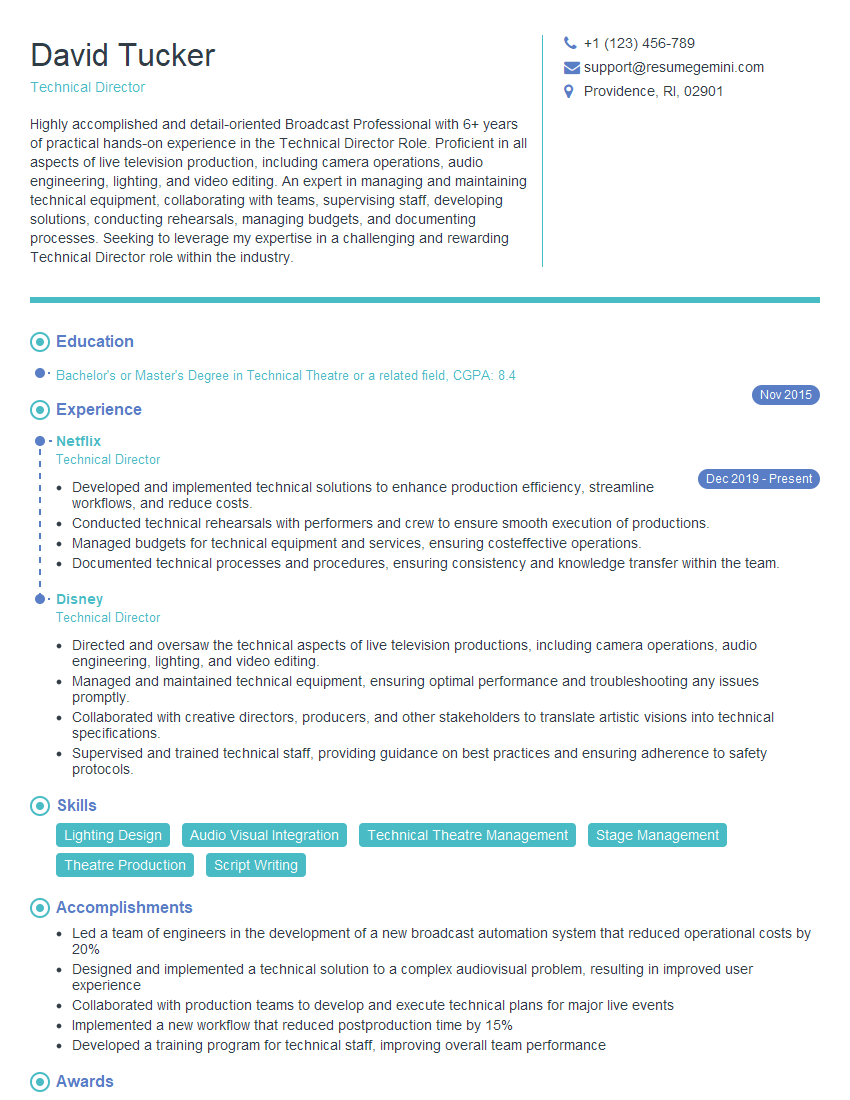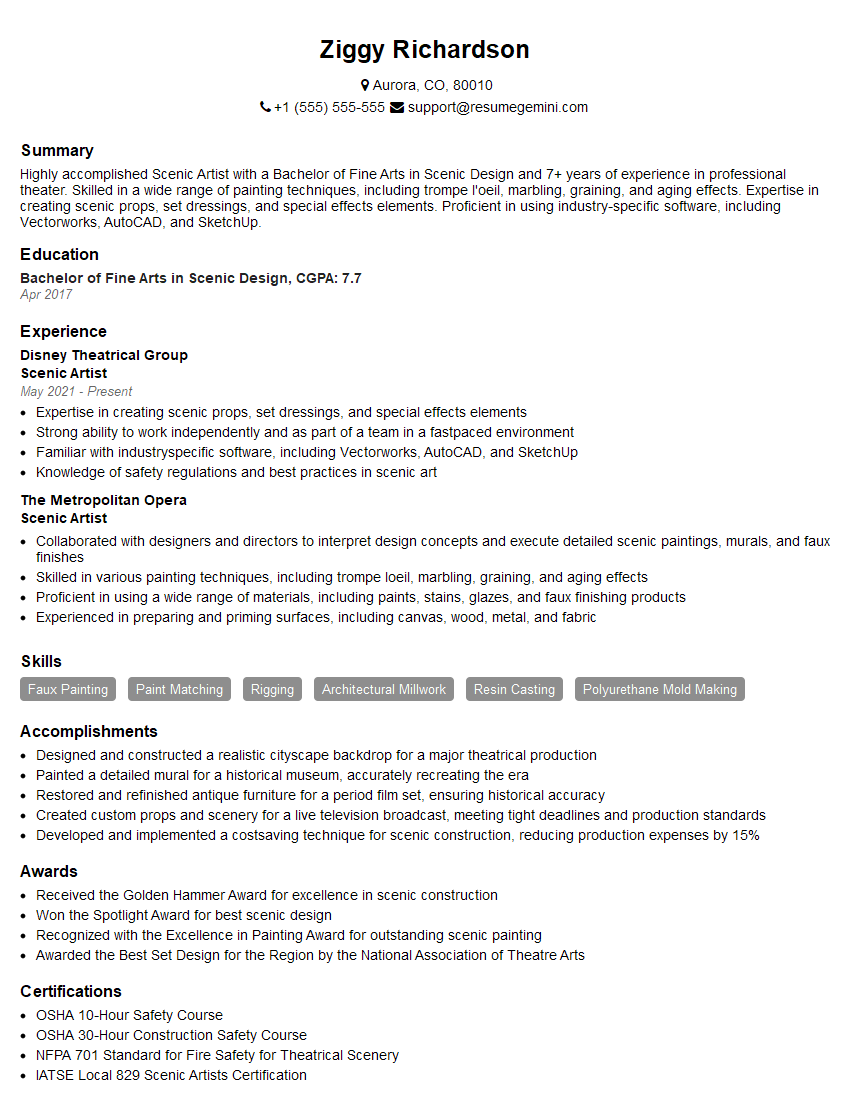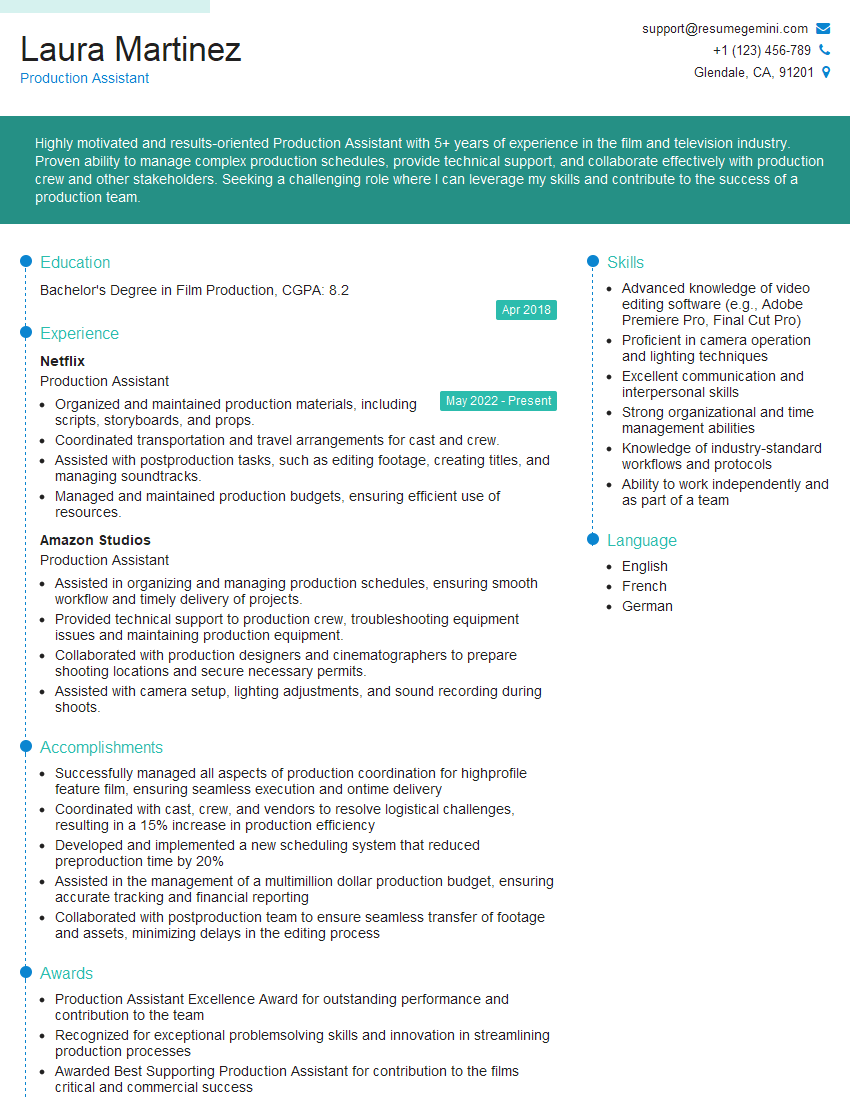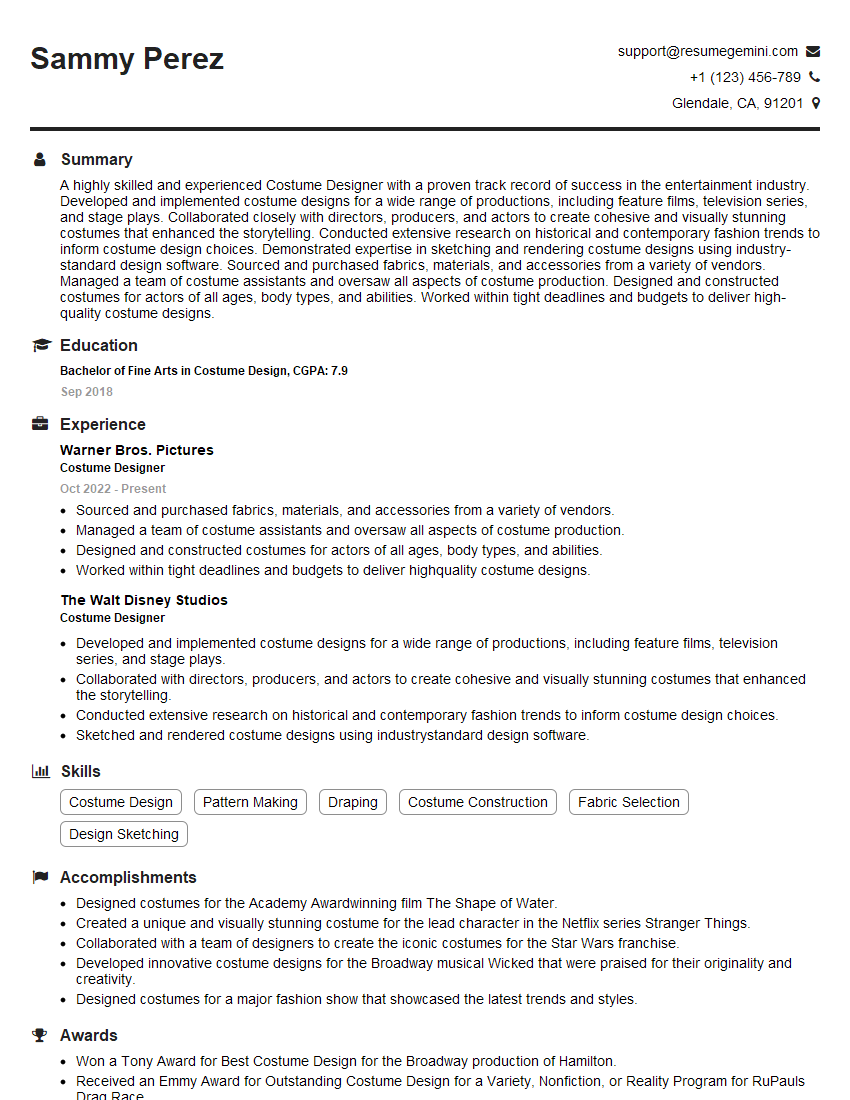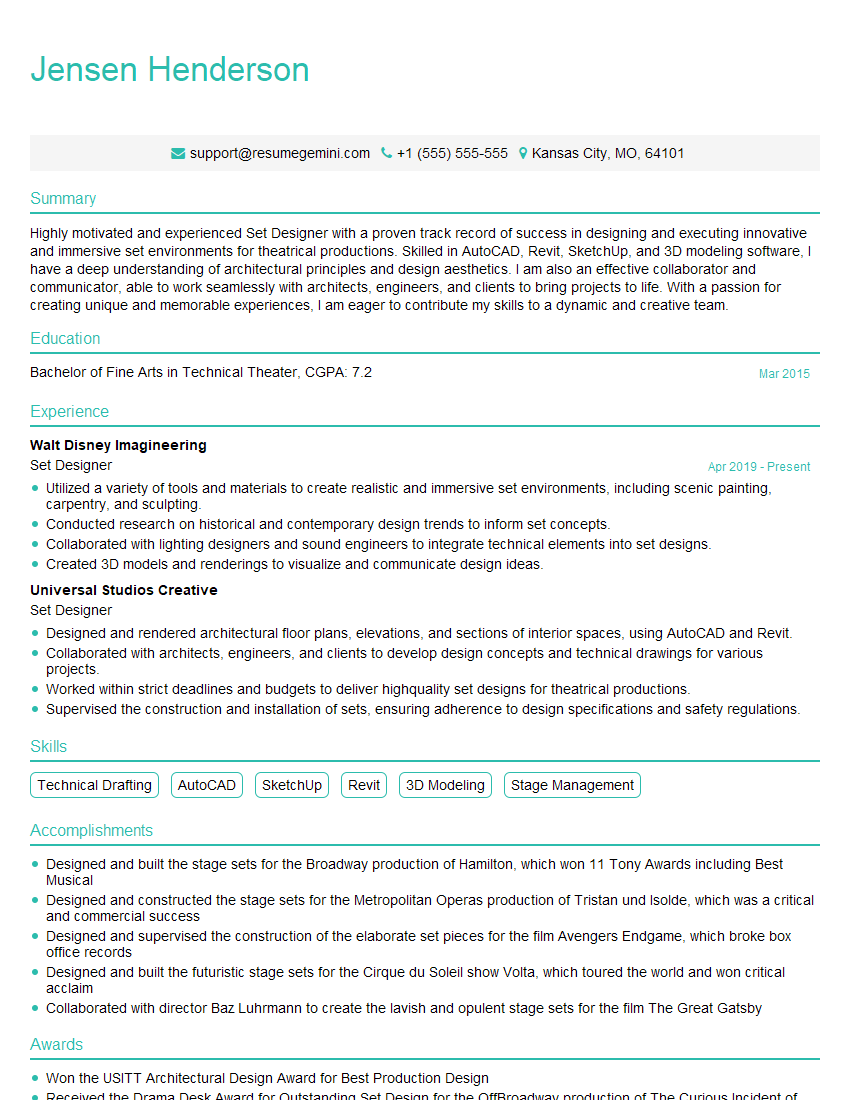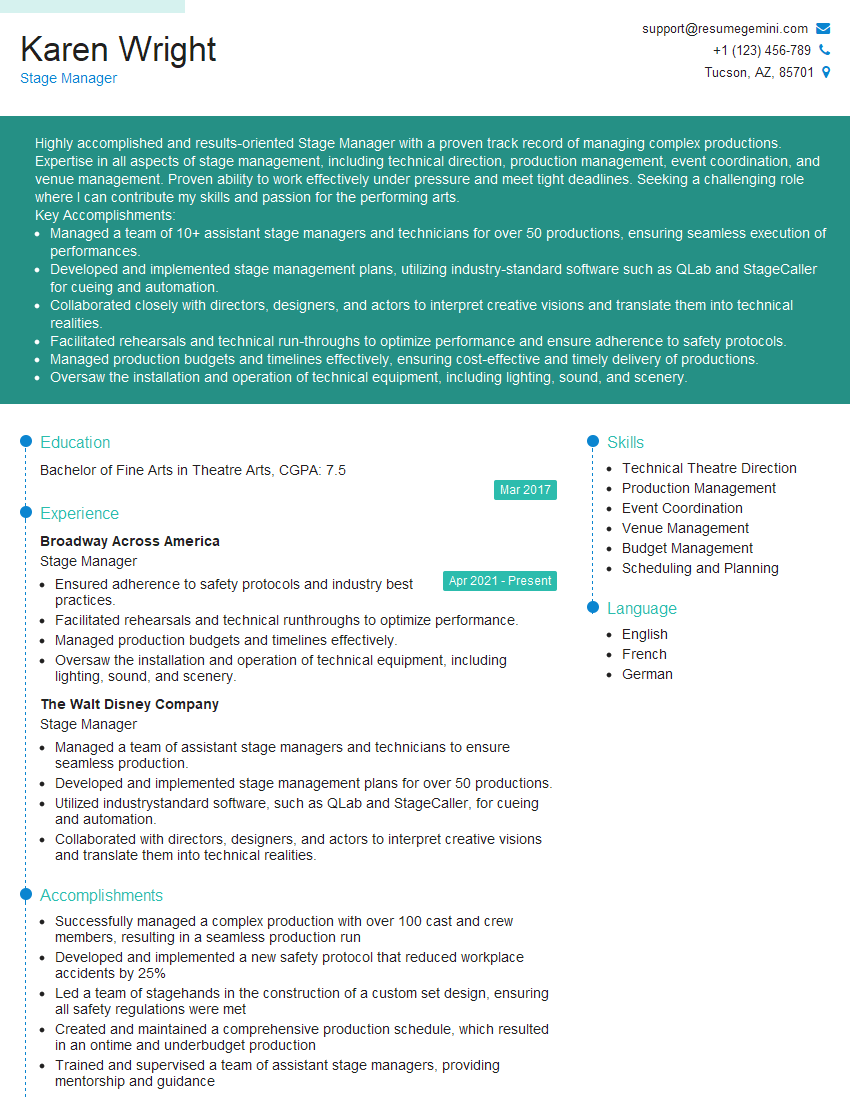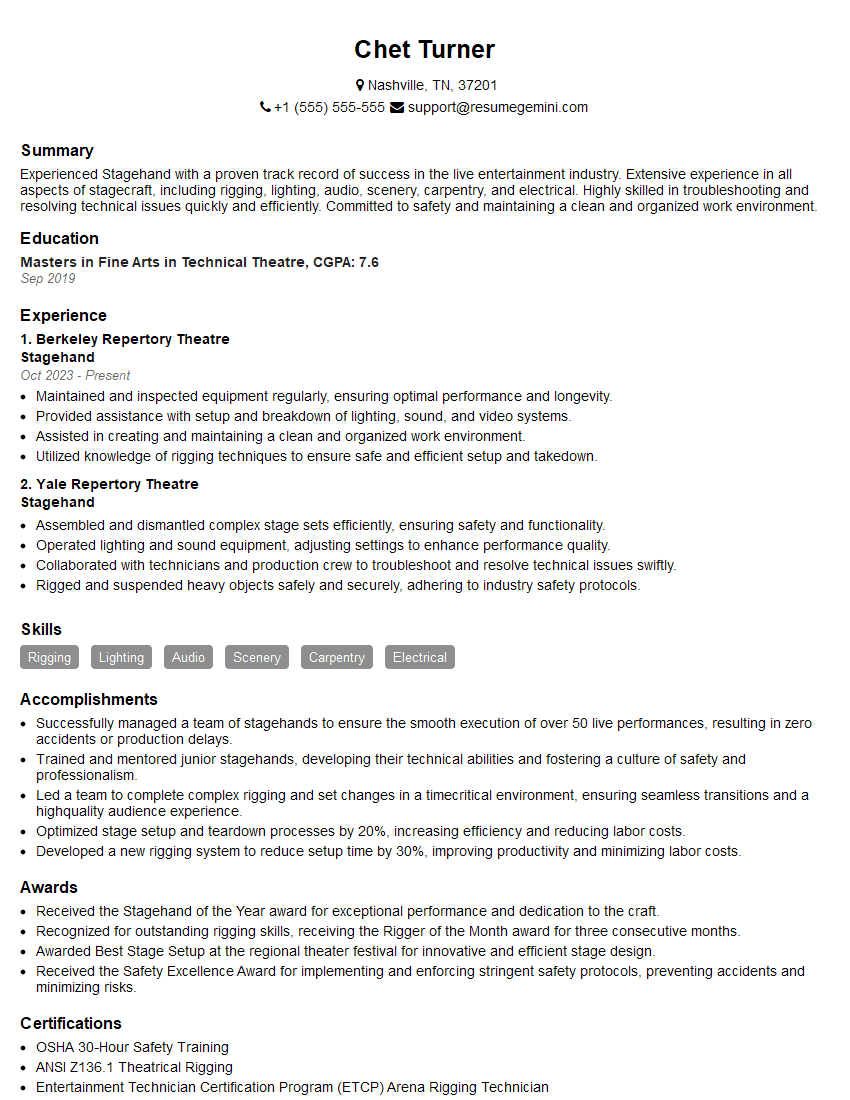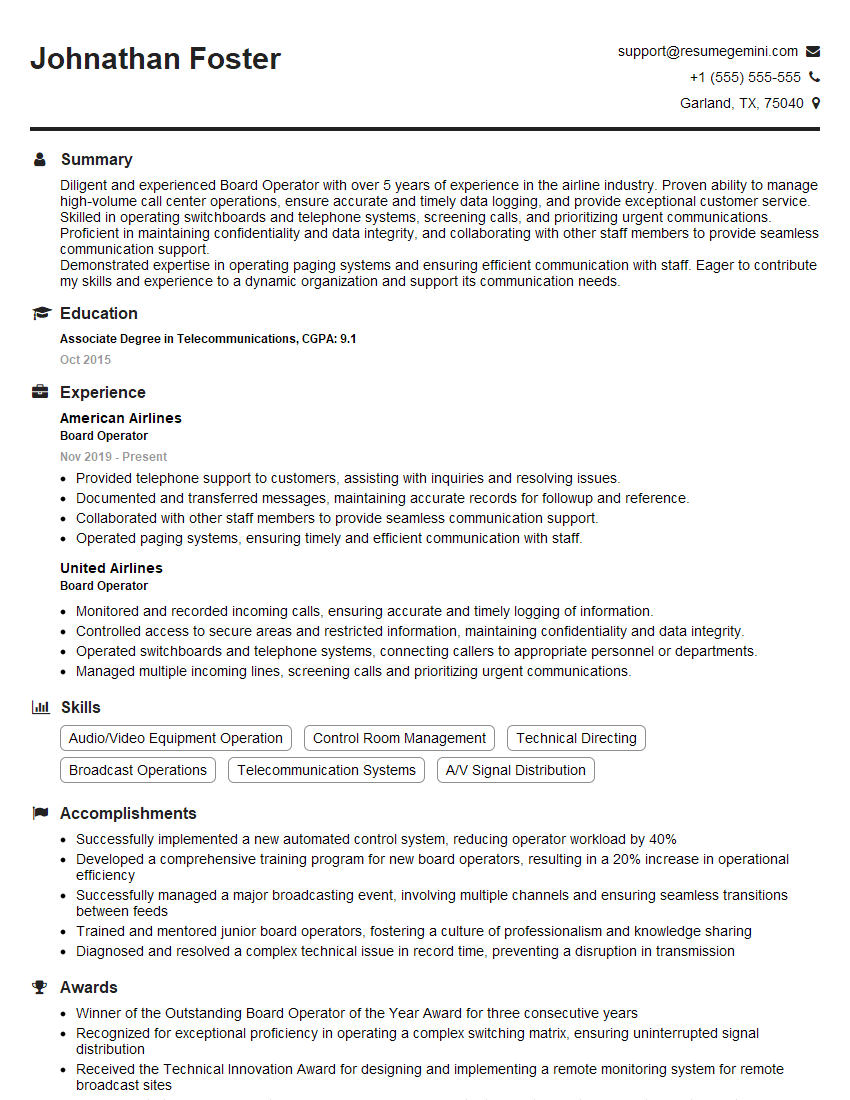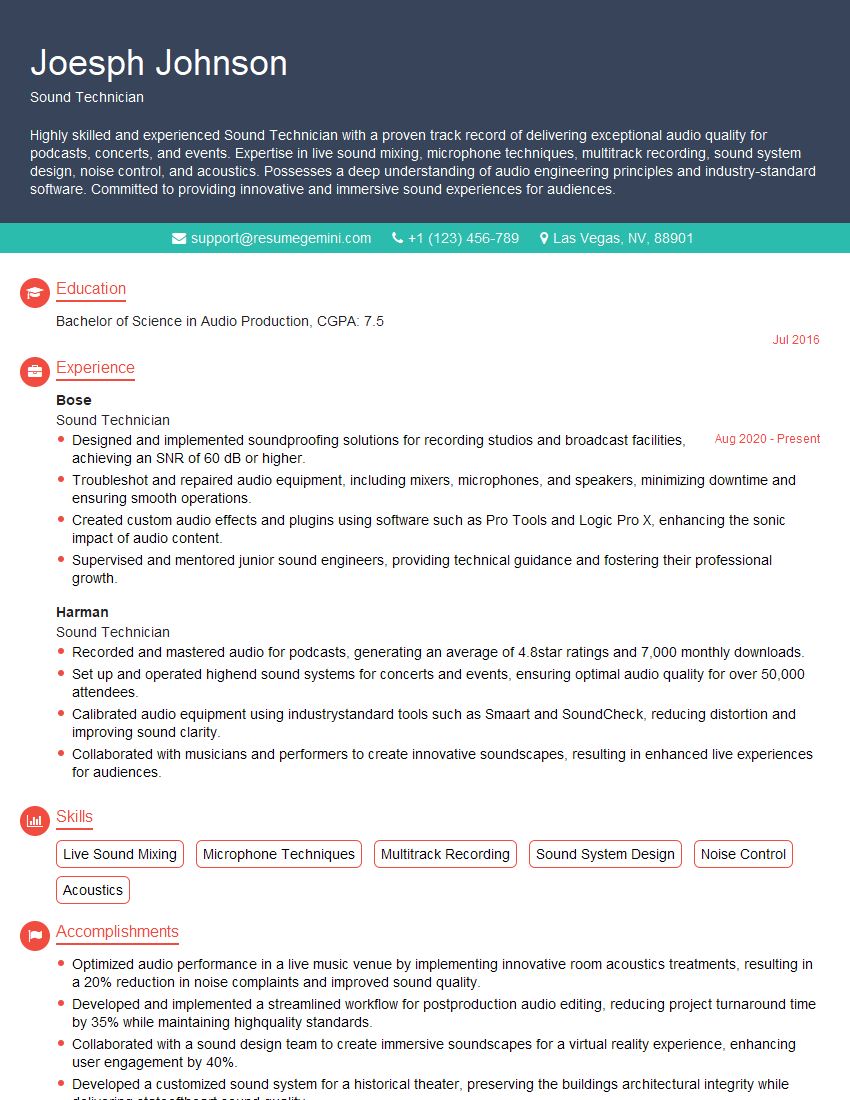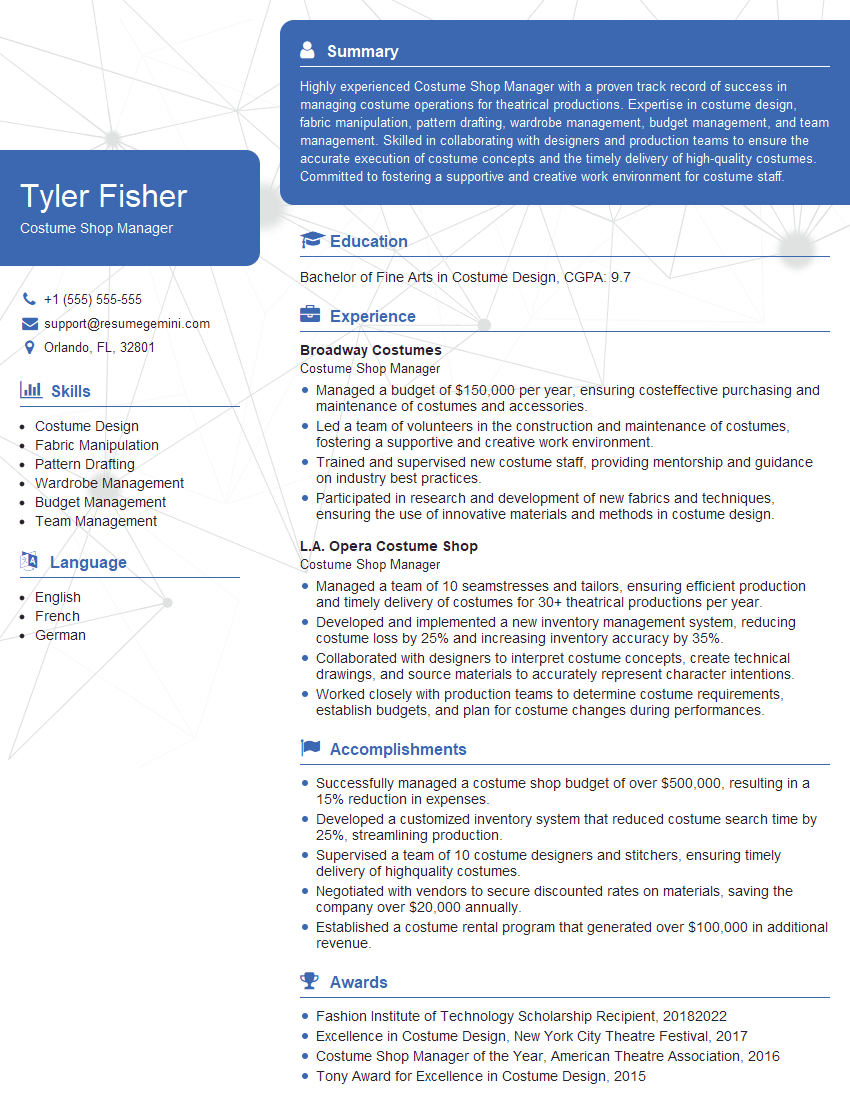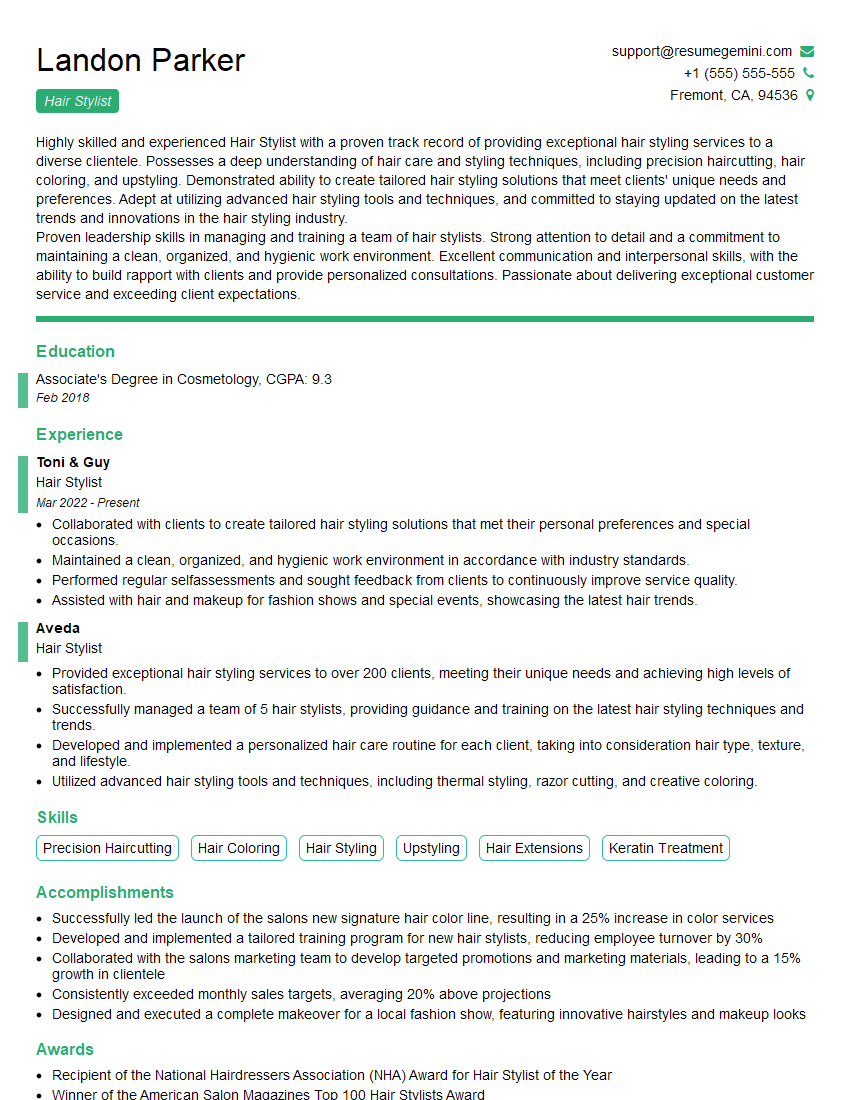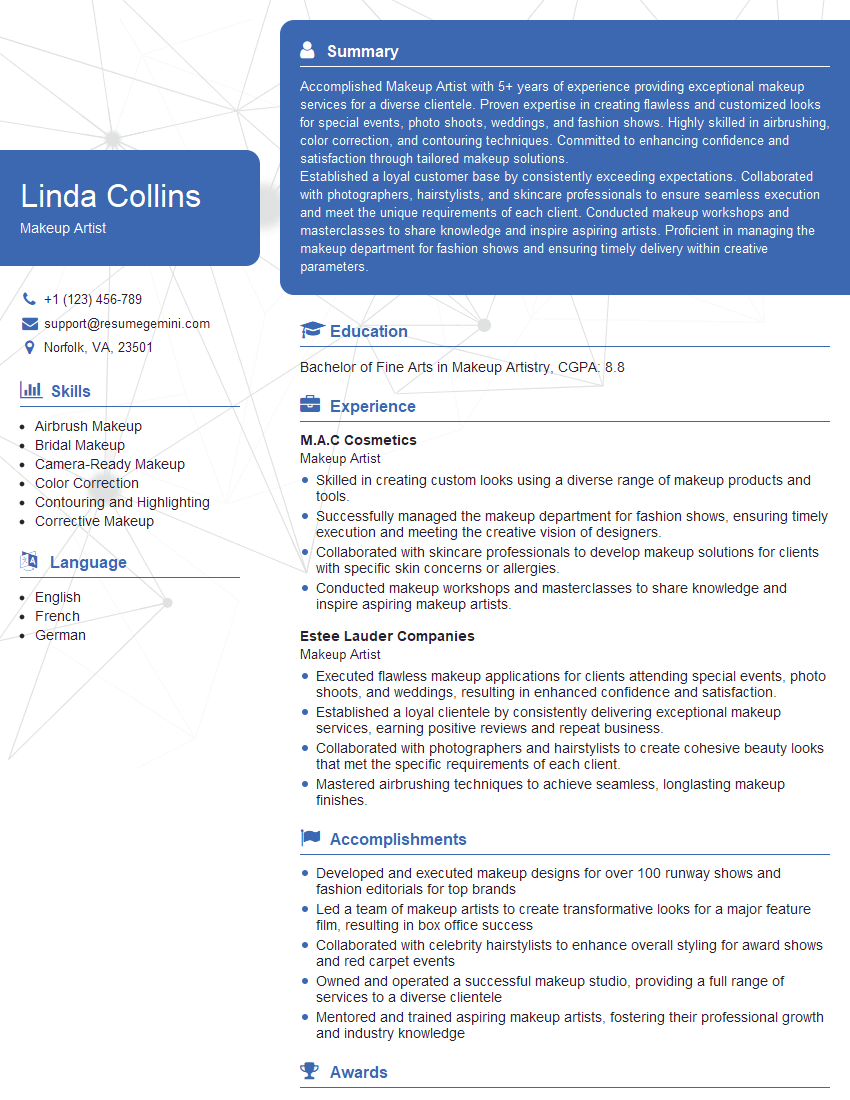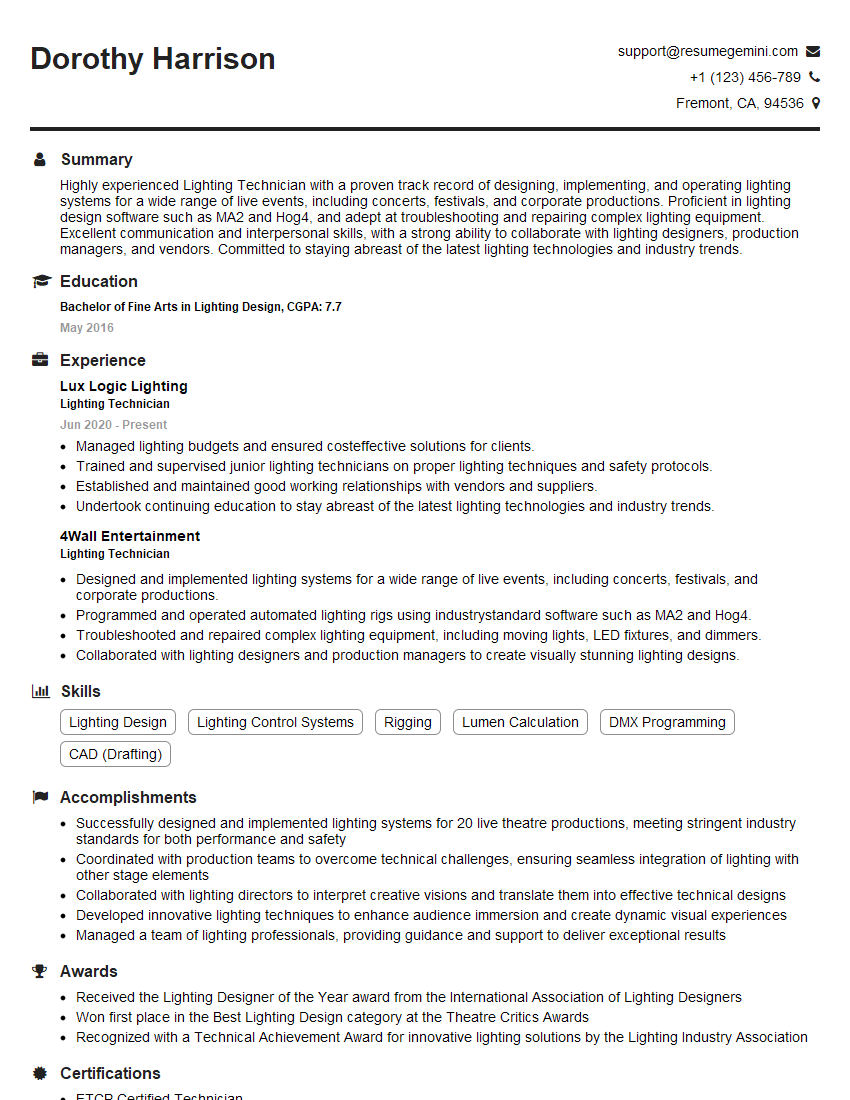Cracking a skill-specific interview, like one for Theater Production, requires understanding the nuances of the role. In this blog, we present the questions you’re most likely to encounter, along with insights into how to answer them effectively. Let’s ensure you’re ready to make a strong impression.
Questions Asked in Theater Production Interview
Q 1. Describe your experience with budgeting and scheduling in a theatrical production.
Budgeting and scheduling are the twin pillars of successful theatrical production. A well-crafted budget ensures we can afford our vision, while a realistic schedule keeps us on track to meet deadlines. My process begins with a detailed breakdown of all anticipated costs: set design and construction, costumes, lighting, sound, marketing, actors’ fees, venue rental, and incidentals. I utilize spreadsheet software like Excel or Google Sheets to meticulously track every expense, forecasting potential overruns and building in contingency funds.
Simultaneously, I create a production schedule, using a Gantt chart or project management software like Asana or Monday.com. This outlines all tasks, assigning responsibilities and deadlines. For instance, set construction might have a start date four weeks before opening night, with specific milestones for each stage, such as framing, painting, and prop placement. This allows for clear communication and proactive problem-solving. A recent production of ‘Hamlet’ involved intricate set changes, necessitating a particularly detailed schedule coordinating the stage crew and carpenters. Close monitoring of both the budget and the schedule throughout the process, including regular reviews and adjustments, is key to delivering the production on time and within budget.
Q 2. Explain your process for creating a lighting plot.
Creating a lighting plot is a collaborative process that begins with a thorough understanding of the script and director’s vision. I start by reading the script multiple times, noting key moments and moods that need to be illuminated. Then, I work closely with the director to discuss their artistic interpretation of the play and translate it into lighting cues. This involves visualizing the stage from various perspectives, considering the set design, and planning the placement of lighting instruments. I use specialized software such as Vectorworks Spotlight to create a detailed plot, which includes the type, position, and angle of each lighting fixture, alongside color specifications and cue instructions. For example, a scene depicting a moonlit forest might require specific gobo patterns projected from specific angles to create the desired atmosphere. Each cue is meticulously timed and linked to specific moments in the script or the director’s blocking notes. The final lighting plot serves as a blueprint for the lighting crew, ensuring everyone is on the same page during tech rehearsals.
Q 3. How do you handle conflicts between different production departments?
Conflict resolution is an inevitable part of theatrical production, as different departments often have competing needs and priorities. My approach centers on open communication and collaboration. I believe in fostering a respectful and inclusive environment where everyone feels comfortable expressing their concerns. When conflicts arise, I facilitate a meeting involving all relevant parties—set, costume, lighting, sound, and stage management. We openly discuss the issue, identifying the root cause and exploring potential solutions together. Compromise is key; finding mutually acceptable solutions that balance all concerns is often necessary. For instance, a conflict might arise between the set designer wanting a complex, multi-level set and the lighting designer needing sufficient space for lighting instruments. The solution might involve adjusting the set design slightly to accommodate lighting needs without significantly altering the artistic vision. Documenting solutions and assigning responsibilities ensures clear action steps and prevents future conflicts.
Q 4. What software are you proficient in for theatrical design or management?
My proficiency in theatrical design and management software includes Vectorworks Spotlight (lighting design), AutoCAD (set design), and QLab (sound and lighting cueing). I am also highly adept at using spreadsheet software such as Microsoft Excel and Google Sheets for budgeting, scheduling, and inventory management. I’m comfortable working with project management tools like Asana and Monday.com to streamline communication and workflow. These tools are essential for efficient and effective production management. For instance, using Vectorworks Spotlight not only allows for creating detailed lighting plots, but also facilitates visualising the lighting design and simulating the effect of the various lighting instruments on the set. This helps avoid costly mistakes and reduces the time required during tech rehearsals.
Q 5. Describe your experience with sound reinforcement and mixing.
My experience in sound reinforcement and mixing encompasses both live performance and recorded media. I’m familiar with various sound systems, microphones, and mixing consoles, including digital consoles like Yamaha and Allen & Heath. My process involves understanding the acoustic properties of the performance space, choosing appropriate microphones for different instruments and actors, and setting up the sound system for optimal clarity and amplification. During the mixing process, I focus on achieving a balanced sound, ensuring that all elements are audible and complement each other. I understand the importance of EQ, compression, and reverb in shaping the overall sound. A recent production of a musical required careful balancing of the live orchestra, vocal mics, and pre-recorded backing tracks, demanding precise EQ and gain staging to avoid feedback and achieve a cohesive soundscape.
Q 6. How do you maintain a safe and efficient backstage environment?
Maintaining a safe and efficient backstage environment is paramount. This involves establishing clear safety protocols, providing adequate training to all backstage personnel, and ensuring that the space is well-organized and free of hazards. We start by conducting regular safety inspections, identifying potential risks such as tripping hazards, electrical hazards, and fire hazards. All crew members receive training on proper lifting techniques, use of equipment, and emergency procedures. Clear signage is used to mark walkways, exits, and equipment locations. A designated space for storing props, costumes, and set pieces is also crucial for maintaining order and minimizing the risk of accidents. Communication is vital; a clear communication system between stage management and the crew ensures everyone knows what is happening and potential hazards are addressed immediately. Regular drills for emergency situations, including fire evacuations, further enhance safety and efficiency.
Q 7. What is your experience with different types of theatrical rigging systems?
My experience with theatrical rigging systems includes both counterweight and automated systems. I’m familiar with the safe operation and maintenance of various rigging components such as linesets, pulleys, counterweights, motors, and control systems. Understanding the load limits and safe working practices for each system is critical. With counterweight systems, I’m proficient in calculating weights, balancing systems, and ensuring proper operation of the system. With automated systems, I’m adept at programming and operating motor-driven rigging to achieve precise movement of scenery and lighting instruments. Regular inspections and maintenance are crucial for both counterweight and automated systems to ensure they are functioning safely and correctly, preventing accidents and damage. A deep understanding of safety protocols and the capacity of different systems is crucial for both operational efficiency and safety.
Q 8. Describe your experience with costume construction and alterations.
My experience in costume construction and alterations spans over 15 years, encompassing everything from basic sewing and pattern making to advanced techniques like draping and millinery. I’m proficient in a wide range of fabrics and construction methods, adapting my approach to the specific needs of each production.
For example, in a recent production of Hamlet, I was responsible for creating over 30 period costumes. This involved sourcing appropriate fabrics, drafting patterns from scratch for several pieces, and then meticulously constructing them, paying close attention to historical accuracy. I also handled numerous alterations during rehearsals, accommodating the actors’ needs and ensuring the costumes fit perfectly and comfortably without compromising the design’s integrity. One challenging alteration involved resizing a very intricate Elizabethan ruff at the last minute due to an actor’s weight change. I had to carefully dismantle and reconstruct sections without damaging the delicate lace and embroidery.
My skills also extend to costume maintenance and repair. I understand the importance of keeping costumes in optimal condition throughout a run, which involves regular inspections, cleaning, and prompt repairs to prevent damage and ensure their longevity.
Q 9. Explain your approach to managing a large crew of stagehands.
Managing a large crew of stagehands requires strong organizational and communication skills, coupled with a clear understanding of the production’s needs. My approach is built on clear delegation, effective communication, and fostering a collaborative team environment. I start by creating a detailed schedule and assigning specific tasks to individuals based on their expertise and experience. This is often done using a digital scheduling tool that allows for easy updates and tracking of progress.
Open communication is vital. I hold regular briefings before each show and after every rehearsal, ensuring everyone understands their roles, any changes to the plan, and addressing any concerns. I also encourage open dialogue and feedback to facilitate problem-solving and improve efficiency. Furthermore, I strive to create a safe and supportive work environment. This involves rigorous safety training, a clear chain of command, and establishing a culture of mutual respect and collaboration.
Think of it like conducting an orchestra – each section (lighting, sound, props, etc.) has its own part, but they all must play in harmony for a successful performance. My job is to ensure everyone knows their part, has the right tools and resources, and plays their part well.
Q 10. How do you troubleshoot technical issues during a performance?
Troubleshooting technical issues during a live performance requires quick thinking, a calm demeanor, and a comprehensive understanding of the technical elements of the production. My approach involves a systematic process focused on rapid assessment, prioritization, and effective problem-solving.
- Assessment: Quickly identify the problem and its scope. Is it a minor issue or a show-stopper? What systems are affected?
- Prioritization: Determine the urgency of the problem and prioritize based on its potential impact on the performance. Some issues may require immediate attention, others can be addressed during intermissions.
- Problem Solving: Use established protocols and available resources to address the problem. This may involve consulting with the technical crew, utilizing backup systems, or employing creative workarounds.
- Communication: Keep the stage manager and other relevant personnel informed throughout the process to ensure coordinated action and prevent further disruptions.
For instance, if a lighting fixture malfunctions during a scene, I’d immediately assess its impact, if it’s critical to the scene’s lighting design, and then switch to a backup fixture or adjust the remaining lights to maintain visual continuity. Communication with the stage manager would be essential to ensure the actors are aware of any changes and to minimize any disruption to the flow of the performance.
Q 11. What is your experience with theatrical drafting software (e.g., Vectorworks)?
I have extensive experience with Vectorworks, utilizing it for drafting detailed stage plots, lighting plots, and set designs. My proficiency extends to creating accurate scale drawings, incorporating 3D modeling for visualization, and generating detailed documentation for construction and technical crews.
For example, in a recent musical production, I used Vectorworks to create a detailed 3D model of the set, allowing for accurate assessment of sightlines and potential design conflicts before construction began. This helped minimize potential errors and save valuable time and resources. The software also allowed me to generate accurate construction drawings for the set builders and detailed lighting plots, with precise fixture positioning, for the lighting technicians.
I’m also proficient in exporting files in various formats to facilitate communication and collaboration with other members of the production team. My ability to seamlessly utilize Vectorworks allows for efficient and accurate documentation throughout the entire design and construction process.
Q 12. How do you manage multiple simultaneous projects in a fast-paced production environment?
Managing multiple simultaneous projects in a fast-paced environment necessitates strong organizational skills, prioritization strategies, and effective time management. My approach is based on a combination of meticulous planning, clear communication, and adaptive problem-solving.
I begin by clearly defining the scope and deadlines for each project, breaking them down into smaller, manageable tasks. I utilize project management tools to track progress, assign responsibilities, and manage deadlines. Prioritization is crucial; I focus on the most urgent and critical tasks first, taking into account their impact on the overall production schedule.
Regular communication with the team is essential to ensure everyone is informed of progress and potential challenges. Flexibility is vital; I’m adept at adapting my plans as unexpected issues arise, always seeking efficient solutions to stay on schedule. Thinking of it as juggling—keeping several projects in the air at once requires constant attention, skill, and a quick response to maintain balance.
Q 13. Describe your experience with creating and implementing a show call.
A show call is a crucial document that outlines the sequence of events and responsibilities for each member of the production team before and during a performance. My experience in creating and implementing show calls involves a collaborative process aimed at ensuring smooth and efficient operations.
I begin by meticulously gathering information from all relevant departments – stage management, lighting, sound, costumes, etc. – to establish a detailed timeline of events, cue times, and specific responsibilities. This is often done through a series of meetings and discussions. The show call is then compiled into a clear, concise document that’s easy for everyone to understand. It typically includes sections for pre-show preparations, the performance itself, and post-show procedures.
Before each performance, I ensure the show call is disseminated to the relevant individuals. I often conduct a brief review of the document with the key crew members to ensure everyone understands their responsibilities and potential challenges. This proactive approach helps prevent miscommunication and ensures a smooth run.
Q 14. Explain your understanding of different types of theatrical lighting instruments.
My understanding of theatrical lighting instruments encompasses a wide range of technologies and their applications. This knowledge enables me to create dynamic and effective lighting designs that enhance the storytelling and visual impact of a production.
I’m familiar with various types of instruments, including:
- Ellipsoidal Reflectors (Leko): Produce a sharp, controlled beam of light, ideal for focusing on specific areas or actors.
- Fresnels: Generate a soft-edged, diffused beam, often used for washes or general illumination.
- PAR Cans (Parabolic Aluminized Reflectors): Produce a broad, intense beam, suitable for backlighting or effects.
- LED fixtures: Offer versatile color mixing and energy efficiency, with different types specializing in specific functions like washes, profiles or effects.
- Moving lights: Provide dynamic and precise control over beam position, color, and gobo patterns, ideal for creating dynamic effects and emphasizing movements on stage.
Knowing the characteristics of each instrument—its beam angle, color temperature, intensity, and focusing capabilities—is crucial for designing effective lighting schemes that support the dramatic narrative. This involves selecting the right instruments for different functions and using them creatively to achieve the desired visual impact.
Q 15. How do you ensure the safety of actors and crew members during rehearsals and performances?
Ensuring the safety of actors and crew is paramount. It’s not just about adhering to regulations, but about fostering a culture of safety from day one. This starts with pre-production risk assessments, identifying potential hazards like stage collapses, pyrotechnics, or even simple trip hazards.
- Pre-Production Risk Assessment: We meticulously survey the venue, identifying and mitigating potential risks. This includes detailed walkthroughs with the stage manager and safety officer, documenting all hazards and devising mitigation strategies. For example, if a stage section is unstable, we’ll reinforce it or redesign the set element causing the instability.
- Rehearsal Safety Protocols: Rehearsals are where many accidents can occur. We establish clear rules for movement on and off stage, ensuring the actors are familiar with the space and any potential hazards. Regular safety briefings reinforce these protocols, and we adapt them based on the specific demands of the scene. For instance, fight choreography needs specialized safety training and padding.
- Performance Safety Checks: Before every performance, a thorough safety check is mandatory. This includes checking rigging, props, lighting, and sound equipment. The stage manager oversees this process, ensuring that everything is functioning correctly and safely. If any issues are identified, they are addressed immediately.
- First Aid & Emergency Procedures: Designated first-aid personnel are always on-site, and everyone involved knows the emergency evacuation procedures. We conduct regular emergency drills to ensure everyone knows exactly what to do in case of fire or other emergencies.
Ultimately, a safe production is a collaborative effort. Open communication between actors, crew, and management is vital to identify and address any potential risks promptly.
Career Expert Tips:
- Ace those interviews! Prepare effectively by reviewing the Top 50 Most Common Interview Questions on ResumeGemini.
- Navigate your job search with confidence! Explore a wide range of Career Tips on ResumeGemini. Learn about common challenges and recommendations to overcome them.
- Craft the perfect resume! Master the Art of Resume Writing with ResumeGemini’s guide. Showcase your unique qualifications and achievements effectively.
- Don’t miss out on holiday savings! Build your dream resume with ResumeGemini’s ATS optimized templates.
Q 16. What is your experience with working with union stagehands?
I have extensive experience working with union stagehands, specifically IATSE (International Alliance of Theatrical Stage Employees) members. Understanding their contracts, working practices, and the importance of collaboration with the union is key to a smooth and efficient production.
- Respecting the Collective Bargaining Agreement: I’ve always meticulously followed the union’s collective bargaining agreement (CBA), understanding and adhering to the rules regarding working hours, pay rates, and job classifications. This fosters positive working relationships and avoids potential conflicts.
- Clear Communication and Collaboration: Effective communication is crucial. I make it a point to clearly communicate the production’s needs and expectations to the union stagehands and actively solicit their input and expertise. Their knowledge of the equipment and the theatre’s specific layout is invaluable.
- Problem-Solving and Teamwork: In theatre, things rarely go exactly as planned. My experience has taught me how to collaborate effectively with the stagehands to problem-solve challenges that arise during rehearsals and performances. For example, during a recent production, an unexpected technical issue arose with the lighting rig. Working with the stagehand crew, we quickly devised a workaround to minimize disruption to the performance.
Working with union stagehands has not only improved production efficiency but has also enriched the collaborative creative process. Their professionalism and experience are invaluable assets to any production.
Q 17. Describe your process for creating a detailed set design.
My set design process is iterative and highly collaborative. It begins with a deep understanding of the script and director’s vision.
- Conceptualization: I start by creating mood boards and sketches, exploring different design concepts that align with the play’s themes and setting. This includes research into historical accuracy, architectural styles, and relevant cultural elements.
- Sketching and Model Making: I then move to detailed sketches, refining the chosen concept. This stage often involves creating scale models to visualize the set’s three-dimensionality, spatial relationships, and overall impact.
- Technical Drawings and Specifications: Once the design is finalized, I create detailed technical drawings, including precise measurements, material specifications, and construction details. This ensures that the builders can accurately construct the set.
- Collaboration and Refinement: Throughout this process, I collaborate closely with the director, production manager, and technical crew. Their input is essential to ensure the design is practical, feasible, and aligns with the budget and available resources.
- Budget and Resource Allocation: A crucial aspect of set design is understanding the budget limitations. I create a detailed budget that outlines all costs associated with materials, construction, and labor. This requires careful consideration of different materials and construction techniques.
For instance, designing a set for a Shakespearean play requires a thorough understanding of Elizabethan architecture and staging conventions, demanding accurate representations while considering the practical limitations of the theatre.
Q 18. How do you incorporate sustainability practices into your theatrical work?
Sustainability is increasingly important in theatre production. I actively incorporate eco-friendly practices into my work, minimizing environmental impact while maintaining artistic integrity.
- Material Sourcing: I prioritize sourcing sustainable and recycled materials whenever possible. This includes using reclaimed wood, recycled fabrics, and locally sourced materials to reduce transportation emissions.
- Waste Reduction: Careful planning and efficient construction techniques minimize waste during the set-building process. This includes utilizing pre-fabricated components where possible and adopting practices to repurpose materials.
- Energy Efficiency: Designing sets with energy-efficient lighting is crucial. LED lighting reduces energy consumption and heat generation.
- Set Life Cycle Management: I always consider the post-production life of the set. Can components be reused in future productions? Can materials be safely recycled or donated?
- Collaboration and Education: Educating the entire production team about sustainable practices is essential. This includes encouraging responsible consumption, waste reduction, and efficient resource management during rehearsals and performances.
For example, in a recent production, we reused existing set pieces from a previous show, dramatically reducing material costs and waste. We also partnered with a local recycling center to ensure responsible disposal of materials after the production.
Q 19. What is your experience with prop construction and sourcing?
Prop construction and sourcing is a key aspect of my work. My approach involves a blend of creative problem-solving, resourcefulness, and attention to detail.
- Sourcing: I begin by assessing the script’s requirements, identifying props that can be sourced readily versus those needing construction. This involves searching through prop houses, antique shops, and online marketplaces. Sometimes, I even fabricate props from scratch.
- Construction: Prop construction often involves a range of skills, including woodworking, metalworking, painting, and sculpting. I use a variety of materials, from readily available craft supplies to more specialized materials based on the prop’s requirements. For example, creating a realistic-looking antique sword might involve metalworking, while a delicate porcelain doll might need more careful craft skills.
- Budget and Time Management: Careful planning and budgeting are essential, considering material costs and construction time. For example, if a prop needs a specific antique finish, I might opt for a more cost-effective replication technique to stay within budget.
- Safety and Functionality: Prop safety is crucial. I always ensure props are durable, safe to handle, and fit for purpose, especially those used in interactions with actors.
For example, I once created a complex clockwork mechanism for a stage prop, requiring precise engineering and careful craftsmanship. This blend of artistry and technical expertise is essential for successful prop creation.
Q 20. Explain your approach to creating a cohesive costume design that supports the overall production concept.
Costume design is integral to the overall production concept; it’s not just about clothing, but about creating visual storytelling. My process emphasizes close collaboration and a deep understanding of the narrative.
- Concept Development: I begin by thoroughly analyzing the script and director’s vision, understanding the characters’ personalities, social status, and the overall mood of the production. This often involves creating mood boards and sketches to explore various design directions.
- Research and Inspiration: This stage involves extensive research into historical periods, cultural influences, and relevant artistic movements to ensure historical accuracy or stylistic consistency. I draw inspiration from various sources like paintings, photographs, and even fashion magazines.
- Character Analysis: A crucial step is developing a deep understanding of each character. How does their clothing reflect their personality and social status? What are their relationships with other characters? The costumes should enhance the character development and support the actor’s performance.
- Fabric Selection and Construction: This stage involves choosing appropriate fabrics that are not only aesthetically pleasing but also practical for movement and stage lighting. The construction process itself considers comfort, durability, and ease of quick changes.
- Collaboration and Fittings: I collaborate closely with the actors, ensuring the costumes fit well, are comfortable, and enhance their performances. Fittings are crucial for adjustments and alterations to make the costumes perfectly suited for each actor.
For instance, designing costumes for a period drama requires meticulous research and attention to detail, ensuring accuracy in fabric, silhouette, and accessories to reflect the era. Conversely, designing costumes for an abstract modern play might involve unconventional materials and textures to achieve a desired visual effect.
Q 21. How do you prioritize tasks when faced with multiple urgent requests?
Prioritizing tasks with multiple urgent requests requires a systematic approach. I use a combination of techniques to manage my workload effectively.
- Prioritization Matrix: I employ a prioritization matrix, often a simple urgency/importance matrix (Eisenhower Matrix). This helps to categorize tasks based on their urgency and importance. Urgent and important tasks get immediate attention, while less urgent tasks are scheduled accordingly.
- Task Delegation: I’m not afraid to delegate tasks when appropriate. This frees up my time to focus on the most critical aspects of the production. For example, I might delegate some prop sourcing to a crew member while I focus on the set design.
- Time Blocking: I use time blocking to allocate specific time slots for different tasks. This ensures focused work periods and avoids task switching, increasing overall efficiency.
- Communication and Collaboration: Open communication with the director, production manager, and crew is essential. This ensures that everyone is aware of priorities and potential bottlenecks. Regular team meetings help to coordinate efforts and address any unexpected issues.
- Flexibility and Adaptability: In theatre, unforeseen challenges are common. I remain flexible and adaptable, adjusting my priorities as needed to address unexpected issues and maintain momentum.
A successful prioritization strategy balances urgent demands with long-term goals, ensuring the smooth progress of the entire production.
Q 22. Describe your experience with designing sound cues for a theatrical performance.
Designing sound cues for a theatrical performance is a multifaceted process requiring a deep understanding of the script, the director’s vision, and the technical capabilities of the venue. It’s not just about adding sound effects; it’s about crafting an immersive soundscape that enhances the storytelling and emotional impact of the production.
My process typically begins with a thorough reading of the script, identifying key moments where sound can contribute to the narrative. I then collaborate closely with the director to discuss their interpretation of the play and how sound can reinforce the themes and atmosphere. This might involve creating a detailed sound plot, a document outlining every sound cue, its timing, and its source.
For instance, in a recent production of Hamlet, we used a subtle, low-frequency drone during the ghost scenes to create a sense of unease and foreboding. In contrast, during the celebratory scenes, we incorporated lively, upbeat music to enhance the feeling of joy and festivity. Each cue is meticulously timed and layered to ensure seamless integration with the action on stage.
Beyond the creative aspects, I also manage the technical execution, ensuring all equipment is functioning correctly and that the sound levels are appropriately balanced. This includes working with the sound engineer to program the sound board, test the system, and troubleshoot any issues during rehearsals and performances.
Q 23. How do you manage the expectations of multiple directors and designers?
Managing the expectations of multiple directors and designers requires exceptional communication and organizational skills. It’s about understanding each individual’s vision and finding creative compromises that satisfy everyone’s artistic goals without compromising the overall integrity of the production.
My approach is to foster open communication and collaboration from the outset. This involves scheduling regular meetings with all key personnel to discuss the creative direction, technical feasibility, and potential challenges. I create a collaborative document, accessible to everyone, that outlines the current state of production and notes any changes or issues. This helps to maintain transparency and avoids misunderstandings.
For example, in a past production, the director wanted a very specific, complex lighting effect that clashed with the sound designer’s plan for a significant sound cue at the same moment. Through discussion, we decided to slightly adjust the timing of the lighting effect to allow both elements to function optimally without overlapping negatively. The key was to maintain respect for all creative contributions and approach conflict as an opportunity for creative problem-solving.
Q 24. Explain your approach to problem-solving when faced with unexpected technical challenges.
Unexpected technical challenges are inevitable in theater. My approach to problem-solving is based on a combination of proactive planning, quick thinking, and collaboration. First, I always have backup plans for crucial equipment, ensuring I have alternative solutions readily available in case of failure.
If a problem does arise, I immediately assess the situation, identifying the root cause and determining the severity of the impact on the performance. I then prioritize the solution based on its urgency. In the event of a minor problem, such as a malfunctioning microphone, I can usually find a quick fix. More significant issues require a more collaborative and strategic approach, which might involve consulting other technicians, adjusting the show slightly, or even finding a creative workaround.
For instance, during a live performance, a crucial sound effect failed. I quickly identified the issue (a corrupted file on the sound board) and, in collaboration with the sound engineer, we were able to swap in an alternative effect that was narratively appropriate, minimizing the disruption to the audience.
Q 25. What is your experience with various stage management techniques?
My experience with stage management techniques is extensive and covers various approaches, from traditional methods to modern digital tools. I am proficient in creating and managing detailed schedules, including rehearsal calendars, cue sheets, and technical specifications. I understand the importance of maintaining clear communication and organization throughout the entire production process.
I’m experienced in utilizing various stage management software like show file, which allows for seamless collaboration and communication with various team members, allowing for real-time updates and tracking of changes to the production. I’m also adept at managing backstage operations, including cueing lighting, sound, and set changes, ensuring smooth transitions between scenes. I understand the importance of maintaining order and efficiency backstage to ensure a seamless performance.
My techniques emphasize proactive problem-solving, risk assessment, and meticulous attention to detail. I’ve worked with both large-scale productions with extensive technical requirements and smaller, more intimate shows, adapting my approach as needed.
Q 26. How do you collaborate effectively with other production team members?
Effective collaboration is fundamental to successful theater production. My approach centers around open communication, mutual respect, and a shared understanding of the production goals. I believe in active listening, clearly articulating my needs and ideas, and being receptive to the input of others.
I initiate regular meetings and utilize shared documents to ensure everyone is informed and on the same page. I am proactive in identifying potential conflicts and work collaboratively to find solutions that benefit the entire team. I also place strong emphasis on building a positive and supportive team environment where everyone feels comfortable expressing their thoughts and concerns. I encourage creative brainstorming and problem-solving sessions to facilitate innovative solutions.
A great example was during a production where the set designer had a vision that presented a major logistical challenge for the stage crew. By working collaboratively with them, and offering alternative solutions for the set construction, we adapted the design slightly, ultimately allowing the director’s vision to be preserved while enabling practical and efficient use of the stage.
Q 27. What is your experience with working with different types of stage technologies?
My experience encompasses a broad range of stage technologies, including traditional and modern systems. I’m proficient in using lighting consoles (like ETC Ion and MA Lighting grandMA2), sound boards (Yamaha, Midas), and various audio-visual equipment. I also possess experience using automated systems for lighting and scenery, as well as video projection and playback technology.
Furthermore, I am familiar with the integration of these technologies, understanding how they interact and how to troubleshoot issues that may arise from their interplay. I am also comfortable working with both analog and digital systems, adapting my approach to the specific requirements of each production.
For instance, in one production, we used a combination of traditional stage lighting and sophisticated moving lights to create a dynamic and visually stunning effect. I worked closely with the lighting designer to program the lighting cues and ensure a smooth and efficient execution during the performances.
Q 28. Describe your experience with pre-production planning and organization.
Pre-production planning and organization are crucial for the smooth execution of any theatrical production. My approach is meticulous and comprehensive, starting with a detailed analysis of the script and the director’s vision. This allows me to establish a clear timeline and identify potential challenges early on.
I develop a detailed production schedule that outlines all key activities, including casting calls, set construction, costume design, rehearsals, and technical rehearsals. This schedule is meticulously maintained and updated, ensuring everyone is aware of their responsibilities and deadlines. I use various project management tools to track progress, manage resources, and communicate effectively with the team.
I also create detailed budgets, ensuring that all costs are accounted for and that financial resources are managed efficiently. I proactively identify potential risks and develop contingency plans to mitigate potential problems. This proactive approach allows me to manage expectations, avoid unforeseen complications and ensure a successful outcome.
For example, in a previous large-scale musical, I developed a detailed production schedule that spanned six months, using Gantt charts and shared digital calendars to ensure everyone was informed and deadlines were met, successfully mitigating potential scheduling conflicts.
Key Topics to Learn for Theater Production Interview
- Production Management: Understanding budgeting, scheduling, and resource allocation. Practical application: Developing a realistic production budget and schedule for a given play.
- Technical Theater: Proficiency in lighting, sound, set design, and stage management. Practical application: Troubleshooting a technical issue during a rehearsal or performance, such as a lighting cue malfunction.
- Collaboration & Communication: Effective teamwork and communication with directors, designers, actors, and technical crews. Practical application: Describing your experience resolving conflicts or facilitating communication within a production team.
- Health & Safety: Knowledge of risk assessment, safe working practices, and emergency procedures. Practical application: Explaining your role in ensuring a safe working environment during a production.
- Stage Directing (if applicable): Understanding of blocking, character development, and directorial vision. Practical application: Discuss your experience working with a director and how you contributed to realizing their creative vision.
- Design Elements (if applicable): Knowledge of set, costume, lighting, and sound design principles. Practical application: Explain your approach to designing a specific element for a production.
- Problem-Solving & Adaptability: Demonstrating the ability to think on your feet and resolve unexpected issues. Practical application: Describe a situation where you had to quickly adapt to a changing production environment.
Next Steps
Mastering Theater Production opens doors to exciting and fulfilling careers, offering diverse opportunities for creative expression and collaboration. To maximize your job prospects, creating an ATS-friendly resume is crucial. A well-structured resume highlights your skills and experience effectively, improving your chances of landing an interview. We recommend using ResumeGemini, a trusted resource for building professional resumes, to craft a compelling document that showcases your unique talents. Examples of resumes tailored to Theater Production are available to help you get started.
Explore more articles
Users Rating of Our Blogs
Share Your Experience
We value your feedback! Please rate our content and share your thoughts (optional).
What Readers Say About Our Blog
Hello,
We found issues with your domain’s email setup that may be sending your messages to spam or blocking them completely. InboxShield Mini shows you how to fix it in minutes — no tech skills required.
Scan your domain now for details: https://inboxshield-mini.com/
— Adam @ InboxShield Mini
Reply STOP to unsubscribe
Hi, are you owner of interviewgemini.com? What if I told you I could help you find extra time in your schedule, reconnect with leads you didn’t even realize you missed, and bring in more “I want to work with you” conversations, without increasing your ad spend or hiring a full-time employee?
All with a flexible, budget-friendly service that could easily pay for itself. Sounds good?
Would it be nice to jump on a quick 10-minute call so I can show you exactly how we make this work?
Best,
Hapei
Marketing Director
Hey, I know you’re the owner of interviewgemini.com. I’ll be quick.
Fundraising for your business is tough and time-consuming. We make it easier by guaranteeing two private investor meetings each month, for six months. No demos, no pitch events – just direct introductions to active investors matched to your startup.
If youR17;re raising, this could help you build real momentum. Want me to send more info?
Hi, I represent an SEO company that specialises in getting you AI citations and higher rankings on Google. I’d like to offer you a 100% free SEO audit for your website. Would you be interested?
Hi, I represent an SEO company that specialises in getting you AI citations and higher rankings on Google. I’d like to offer you a 100% free SEO audit for your website. Would you be interested?
good

